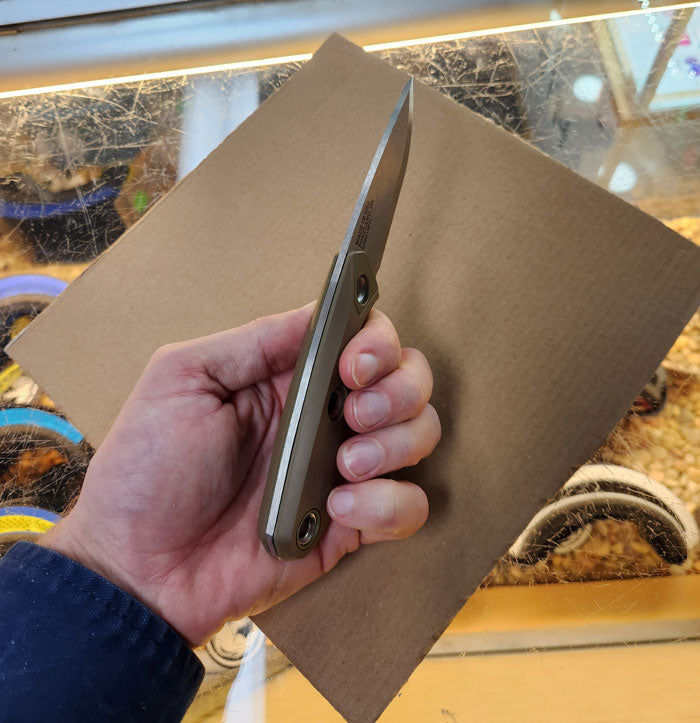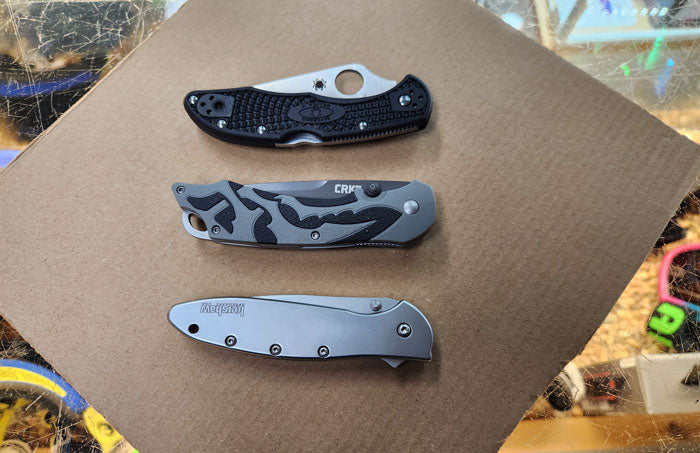
Buying Guide: Knives, Axes, and Tools
When it comes to purchasing a knife or a tool, options are so expansive that shopping can easily become overwhelming. In this blog post, I'll break down the world of axes, multitools, and knives. Whether you are a first-time shopper buying a Christmas gift or a backcountry aficionado looking to expand your kit, I’ll provide key features to look for in your search.
The world of knives is expansive for a reason- each knife is built for a different purpose. There are knives for opening boxes or for backcountry survival. There are axes for splitting wood, and hatchets better for carving or shaving tinder. There are even knives and axes designed specifically for throwing. This may sound obvious, but it's really important before you begin shopping to ask yourself:
- What will this knife (or axe, or multitool) be used for?
The worst mistake you can make when purchasing a knife is to buy something you don't need- something that doesn't have the capabilities you're looking for. Should you buy a folding or a fixed blade knife? Do you need an axe with a 36-inch handle, or a hatchet with a 10-inch handle? Knowing what you'll use the tool for will help to answer these questions.

Types of Steel and other Blade Materials
One of the first things you’ll notice when looking at axes, multitools, and knives is that there often seems to be a huge price discrepancy between very similar-looking products. How can one knife cost $20, while a nearly identical-looking knife costs over $100? Not all knives are made of the same material. There are budget steels, and then there are premium steels. Because different companies use different materials, it is hard to create a ranking of steels; however, there are plenty of resources available online if you want to dig deeper into this. Many knives will have their steel type printed directly on the blade.
The intended use of a tool will help determine which material might be best for you. Some steels may be harder and will hold an edge for longer; others may be softer and dull faster, but will also be easier to sharpen. Resistance to corrosion can be important if you will not always be able to clean your tool directly after use or if it will frequently be wet. If blade material is important to you, pay particular attention to hardness, edge retention, ease of sharpening, and resistance to corrosion.
Some knives, especially fixed blades (see below) are available in either stainless steel or carbon alloy. While carbon blades are harder and are easier to sharpen, they are also more brittle (can be chipped) and are less resistant to corrosion and rusting.

Axes, Hatchets, and Larger Tools
When it comes to axes and hatchets, there are two main considerations: material and size.
The strength of an axe head (and ease of sharpening) is particularly important because axes need to stand up to heavy impact. Axes can be machine cast or hand forged. Generally, hand forged axes will be more expensive, but constructed from a nicer steel and have better edge shape, durability, and ease of sharpening.
The size of the axe you choose should be relative to the distance you want to be from the item you are cutting. The ideal axe for splitting wood or cutting limbs off of trees will have a long handle and a larger, heavier head since you will be standing back and swinging at objects. For cutting up smaller logs and shaving kindling, a shorter handle and smaller head will give you the edge you need for precision work.
 A medium sized handle and head are good for splitting wood
A medium sized handle and head are good for splitting woodStaff Picks:
- Hand Forged Slavic Chopping Axe - a great deal on a hand forged axe, small and lightweight with a carbon alloy blade perfect for practice sharpening.
- Texsport Polished Steel Hand Axe - an inexpensive machine cast axe, smaller in size and easily transportable for cutting kindling during camping trips
- Stansport Machete - a good tool to have for cutting away Oregon blackberry bushes and clearing overgrowth
- Sven Saw - light, compact, and easily foldable camp saw for backpacking
 Machetes are great for brush clearing and yard work
Machetes are great for brush clearing and yard workMultitools
Some multitools are intended for carrying on a keychain while others are best stored in a toolbox. While the material is still important, your selection should mainly be based on the tools included and size of the product.
Here in Portland, we are lucky to live near the manufacturing headquarters of a number of multitool companies, including Leatherman and Gerber. Here are some of my favorites:
- Gerber Dime - A miniature 12-tool multitool built around a set of spring-loaded pliers. The dime is the perfect size to attach to a keychain and travel with you wherever you go.
- Leatherman Free P2 – One of the most comprehensive multitools available. Built around a set of pliers, the Free P2 includes 19 tools and is great for supplementing (or replacing) your toolbox.
- Leatherman Free K2X - A minimal multitool built around a large pocketknife with a serrated blade
 Leatherman in action
Leatherman in actionKnives
There are two basic categories of knives: fixed blade and folding. Fixed blade knives are stored in a sheath, while folding knives are more traditional “pocket knives” with blades that fold into the handle for safe storage.
Fixed Blade Knives
Because the blade is permanently mounted to the handle, these knives are particularly durable. If you’re looking for a knife for carving wood or frequent chopping, a fixed blade knife will work better than a folding knife. Though there are many features that differentiate fixed blade knives including material, blade size, and shape, the most important feature is tang.
Tang refers to how far the metal blade of a knife extends backward into the handle. In a full tang knife, the metal blade will continue all the way back to the hilt (butt end) of a knife; in a partial tang knife, the metal blade will end partway through the handle. The more tang a knife has, the stronger it will be and the more force you can put into the knife handle before the knife will break.
Staff Picks:
- Gerber Spine - A compact full-tang fixed blade knife, the perfect shape and size for use around the campsite
- Kershaw Brace Neck Knife - A tiny full-tang knife, made to be carried in a sheath worn around the neck for easy access
- Morakniv Eldris - A lightweight, compact partial-tang fixed blade knife, perfectly sized to carry in your pocket
- Morakniv Bushcraft - A large, robust fixed blade knife made of carbon steel with a corrosion-resistant coating. ¾-length tang makes this knife sturdy and perfect for serious outdoor work.
 The Gerber Spine, a full-tang fixed blade knife
The Gerber Spine, a full-tang fixed blade knife
Folding knives
Folding knives are designed to stow away safely in a pocket for everyday use. Like with all other tools, material and size are both important considerations when selecting a folding knife. Smaller lightweight knives are great for simple tasks such as opening packages, while larger more industrial knives are good for heavier use. Consider whether you want a knife made with high grade steel that will hold an edge for a long time, or a knife with lower grade steel that might require more frequent sharpening. Another important consideration is the opening mechanism on a folding knife.
- Automatic knives are designed for quick, easy opening; usually there is a button located in the handle that you push to launch the blade into position. Consider the safety on an automatic knife, and whether there is a way to lock the blade in place when it is folded away and being carried in a pocket.
- Assisted opening knives contain a spring in the handle that enables the blade to launch into place; however, opening the knife and triggering the spring will require a bit of manual force to begin opening the knife. Assisted knives are slightly harder to open than automatic knives, but can still be opened with one hand.
- Unassisted knives contain no spring in the handle, and therefore usually require two hands to open. Unassisted knives will be less expensive, but require more work to use.
Finally, there are a few additional features to consider when choosing a folding knife. Consider how an assisted or unassisted knife will be opened- does the knife include a thumb stud, or maybe a tab near your index finger to assist in opening, and which do you prefer? The handle material can make a difference; some handles are made of heavier, more durable metal while others are made of plastic or rubber with specially designed grips to aid in holding the knife. Some knives have clips, designed to attach the knife to a belt loop or the edge of a pocket. Some are field strippable, which means they can be taken apart for easy cleaning; these knives are designed for use in the backcountry or for messier work.
 Example of a field-stripable knife
Example of a field-stripable knifeOregon and Washington are the location of a number of knife brands and manufacturers including CRKT, Kershaw, SOG, and Gerber. We are lucky to often be able to buy local when shopping knives. Here are a few staff picks to consider when knife shopping:
Sheffield Chaser - An amazing price for a small, full-metal knife designed for everyday use and easy carrying.
Kershaw Leek - One of my favorite assisted folding knives, compact with an easy-opening tab and a higher end steel for easy sharpening, made in Tualatin.
Kershaw Launch 9 - A tiny automatic knife, perfect for quick access.
Sypderco Dragonfly - Small, lightweight, and durable, a great knife for camping or backpacking

A Quick Note on Legality
A quick note on legality: knife laws vary by state. While very few places have laws against owning knives, if you plan to carry the knife in your pocket throughout the day, make sure you are familiar with the local restrictions before buying. Different states have laws regarding legal blade length and opening mechanisms (some states allow certain types of automatic knives, others don't). Since you're allowed to own and use knives on private property, there are no laws restricting what retailers can sell you- but you don't want to purchase a knife for everyday carry, then discover you can't use it.
Conclusion
Hopefully after reading this guide, you feel better equipped to purchase a knife, axe, or multitool. One final note: though you can read pages and pages of information on the features of knives and other tools, there’s little substitution for handling a knife in the store. Things like how a knife handle feels in your hand, how the weight balances, and how a folding mechanism works can only really be understood after holding a knife. Fortunately, almost all knife retailers will allow you to handle a knife before purchasing it. So now that you know what to look for when purchasing a knife, head into your local retailer to check out some tools!


